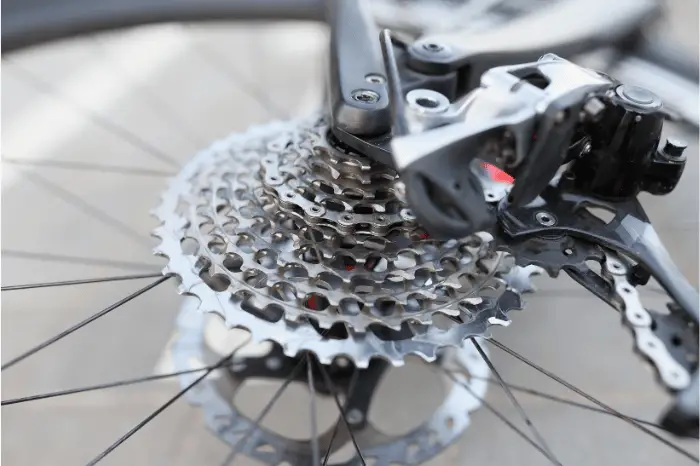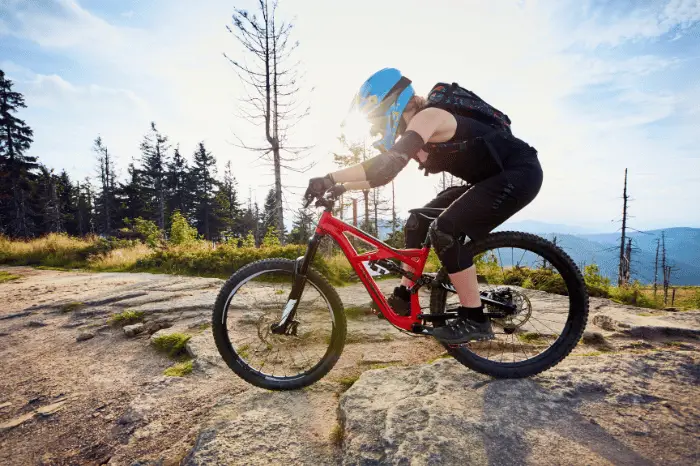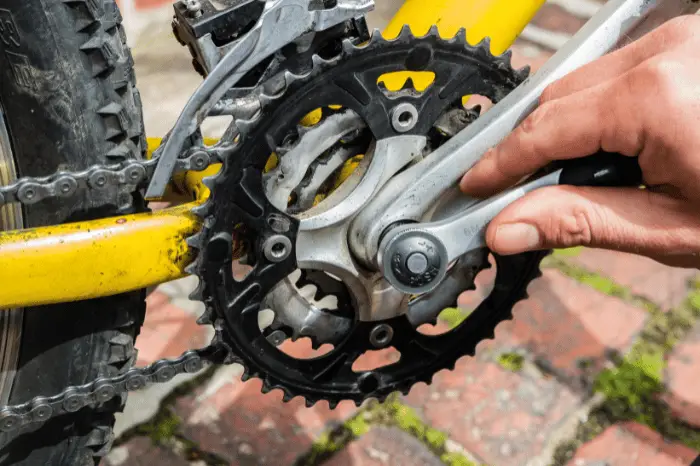
If you’re new to mountain biking, understanding how to use gears can seem overwhelming. However, once you understand how gears work and how to use them, you’ll be able to tackle even the toughest terrain with ease. Gears allow you to adjust your speed and control the resistance you feel as you pedal, making it easier to climb steep hills and navigate challenging terrain.
The number of gears on a mountain bike can vary, but most bikes have multiple gears in the front and possibly in the back. The front gears, or chainrings, are located near the pedals, while the rear gears, or cogs, are located near the rear wheel. By shifting gears, you can change the ratio of the chainrings and cogs, making it easier or harder to pedal depending on the terrain.
Learning how to use gears effectively takes practice, but it’s an essential skill for any mountain biker. In this article, we’ll explore the basics of mountain bike gearing, including how gears work together, how to shift gears, and how to choose the right gear for different terrain. Whether you’re a beginner or an experienced rider, understanding how to use gears can help you enjoy your mountain biking experience to the fullest.
Understanding Gear Ratios
Gear Ratio Basics
When it comes to using mountain bike gears, understanding gear ratios is crucial. A gear ratio is a relationship between the number of teeth on two gears that are meshed together. It helps determine the speed and power output of your bike. The gear ratio is calculated by dividing the number of teeth on the front chainring by the number of teeth on the rear cassette cog. For example, if you have a bike with a 32-tooth chainring and an 11-tooth cassette cog, the gear ratio is 2.91:1.
Mountain bikes usually have a wide range of gears to help you tackle different terrains. The gear ratio affects how easy or hard it is to pedal. A lower gear ratio makes it easier to pedal uphill, while a higher gear ratio makes it easier to pedal downhill.
Importance of Gear Selection
Choosing the right gear ratio is important for a comfortable and efficient ride. If you choose a gear that is too high, you will have to push harder to pedal, which can tire you out quickly. On the other hand, if you choose a gear that is too low, you will spin your pedals too fast and not generate enough power to move forward.
It’s important to choose the right gear for the terrain you are riding on. If you are going uphill, shift to a lower gear to make pedaling easier. If you are going downhill, shift to a higher gear to maintain your speed. When shifting gears, it’s best to shift one gear at a time and avoid shifting gears under heavy load.
In conclusion, understanding gear ratios is an important aspect of using mountain bike gears. Choosing the right gear ratio for the terrain you are riding on can make your ride more comfortable and efficient.
Types of Mountain Bike Gears
When it comes to mountain bike gears, there are a few types to choose from. Each type has its advantages and disadvantages, and the choice ultimately depends on your personal preference and riding style. Here are three common types of mountain bike gears:
Derailleur Systems
Derailleur systems are the most common type of mountain bike gears. They use a chain and a series of gears to transfer power from the pedals to the wheels. The derailleur system consists of a front derailleur and a rear derailleur, which work together to shift the chain between gears. The front derailleur moves the chain between the chainrings, while the rear derailleur moves the chain between the cassette cogs.
One of the advantages of derailleur systems is that they allow for a wide range of gear ratios, making it easier to tackle steep climbs and fast descents. They are also relatively lightweight and easy to maintain. However, derailleur systems are prone to damage from rocks and debris, and they require frequent cleaning and adjustment to work properly.
Internal Gear Hubs
Internal gear hubs are an alternative to derailleur systems. They use a hub-mounted gearbox to transfer power from the pedals to the wheels. Internal gear hubs are enclosed, which makes them more resistant to damage from rocks and debris. They also require less maintenance than derailleur systems.
One of the main advantages of internal gear hubs is that they allow for a clean and simple chainline, which reduces wear on the chain and cassette. They also allow for easy shifting when stopped, which can be useful in stop-and-go traffic or on technical terrain. However, internal gear hubs are heavier than derailleur systems, and they have a limited range of gear ratios.
Electronic Shifting Systems
Electronic shifting systems are a relatively new type of mountain bike gear. They use a battery-powered motor to shift the chain between gears. Electronic shifting systems are precise and reliable, and they require minimal maintenance.
One of the advantages of electronic shifting systems is that they allow for precise and effortless shifting, even under load. They also allow for customization of the shifting process, which can be useful for riders with specific preferences. However, electronic shifting systems are expensive and require a power source, which can be a disadvantage for long rides or remote areas.
Shifting Techniques

When it comes to using mountain bike gears, shifting techniques play an important role in ensuring a smooth and efficient ride. Here are some tips to help you shift gears like a pro.
Timing Your Shifts
Timing your shifts is crucial when it comes to mountain biking. You need to anticipate the terrain ahead and shift accordingly to maintain your momentum. For example, if you see a steep climb ahead, you should shift to a lower gear before you reach the hill. This will help you maintain your cadence and prevent you from stalling out.
On the other hand, if you’re approaching a downhill section, you should shift to a higher gear to maximize your speed and control. Timing your shifts properly will not only help you maintain your speed and momentum, but it will also reduce the strain on your bike’s drivetrain.
Managing Cadence and Resistance
Managing your cadence and resistance is another important factor when it comes to shifting gears. Your cadence refers to the speed at which you pedal, while resistance refers to the difficulty level of pedaling. By managing these two factors, you can ensure that your shifts are smooth and efficient.
When you shift gears, you should aim to maintain a consistent cadence. This means that you should pedal at the same speed before and after the shift. If you shift gears and your cadence drops too low, you may struggle to regain your momentum.
At the same time, you should also pay attention to the resistance level. If you’re in a high gear and the resistance is too high, you may struggle to pedal and may even risk damaging your bike’s drivetrain. On the other hand, if you’re in a low gear and the resistance is too low, you may spin out and lose control.
By managing your cadence and resistance, you can ensure that your shifts are smooth and efficient, allowing you to tackle any terrain with ease.
Maintaining Your Gearing System

To ensure that your mountain bike’s gearing system performs optimally, you need to maintain it regularly. Here are some tips to help you keep your gearing system in top condition.
Regular Cleaning
Keeping your bike clean is essential to maintaining its performance. Dirt, dust, and grime can accumulate on your bike’s gearing system, causing it to malfunction. Regularly cleaning your bike’s gearing system will help prevent this.
To clean your gearing system, you’ll need a degreaser, a brush, and a clean rag. First, apply the degreaser to the chain, cassette, and chainrings. Use the brush to scrub away any dirt and grime. Then, wipe the parts clean with a rag. Repeat this process until the parts are clean.
Adjusting Derailleurs
If your bike’s gears are not shifting smoothly, your derailleurs may need adjustment. Derailleurs are the components that move the chain from one gear to another. If they are not adjusted correctly, your bike’s gears will not shift smoothly.
To adjust your derailleurs, you’ll need a Phillips screwdriver and a 5mm Allen wrench. First, shift your bike into the highest gear (smallest cog in the back, largest chainring in the front). Then, use the Phillips screwdriver to adjust the high-limit screw on the rear derailleur until the jockey wheel is aligned with the smallest cog. Next, shift your bike into the lowest gear (largest cog in the back, smallest chainring in the front). Use the 5mm Allen wrench to adjust the low limit screw on the front derailleur until the chain is aligned with the largest chainring.
Replacing Worn Components
Over time, your bike’s gearing system will wear out. Worn components can cause your bike’s gears to slip or not shift at all. It’s essential to replace worn components to keep your bike’s gearing system functioning correctly.
The most common components that wear out are the chain, cassette, and chainrings. You can check the wear on your chain using a chain wear tool. If the wear is above 0.75%, it’s time to replace the chain. If you don’t replace a worn chain, it will wear out the cassette and chainrings faster.
Replacing the cassette and chainrings can be a bit more complicated. You’ll need a chain whip, cassette lockring tool, and a crank puller. If you’re not comfortable doing this yourself, take your bike to a professional bike mechanic.
By following these tips, you can keep your mountain bike’s gearing system in top condition. Regular maintenance will ensure that your bike shifts smoothly and performs optimally.
Troubleshooting Common Gear Issues
Mountain bike gears can be finicky at times, and it’s not uncommon to experience issues with them. Luckily, many of these issues can be resolved with a few simple adjustments. In this section, we’ll cover some common gear issues and how to troubleshoot them.
Skipping Gears
If your bike is skipping gears, it’s likely due to a misaligned derailleur. To fix this issue, you’ll need to adjust the derailleur’s alignment. Here’s how to do it:
- Shift to the smallest chainring and the largest cog on the cassette.
- Loosen the derailleur cable.
- Use the barrel adjuster on the shifter to center the derailleur over the cog.
- Tighten the derailleur cable.
If this doesn’t fix the issue, you may need to replace the chain or cassette.
Gear Slipping
Gear slipping is another common issue that can be caused by a worn chain or cassette. To fix this issue, you’ll need to replace the worn component. Here’s how to do it:
- Shift to the smallest chainring and the largest cog on the cassette.
- Remove the rear wheel.
- Use a chain whip and cassette lockring tool to remove the cassette.
- Install the new cassette.
- Install the rear wheel.
If the issue persists, you may need to adjust the derailleur’s cable tension or replace the derailleur altogether.
Noise During Shifting
If you hear a lot of noise when shifting gears, it’s likely due to a misaligned derailleur or worn components. To fix this issue, you’ll need to adjust the derailleur or replace the worn component. Here’s how to do it:
- Shift to the smallest chainring and the largest cog on the cassette.
- Loosen the derailleur cable.
- Use the barrel adjuster on the shifter to center the derailleur over the cog.
- Tighten the derailleur cable.
If the issue persists, you may need to replace the chain or cassette.
Frequently Asked Questions
How do I properly shift gears on a mountain bike?
Shifting gears on a mountain bike is crucial for a comfortable and efficient ride. To properly shift gears on a mountain bike, you need to start by pedaling at a steady pace. Then, use your gear shifter to move the chain onto a higher or lower gear. It is important to shift gears before you start pedaling uphill or downhill. You should also avoid shifting gears too quickly or too abruptly as this can damage your bike’s chain and gears.
What do the gear numbers on a mountain bike indicate?
The gear numbers on a mountain bike refer to the number of teeth on the front and rear gears. The larger the number of teeth, the harder it is to pedal, but the faster you can go. Conversely, the smaller the number of teeth, the easier it is to pedal, but the slower you can go. For example, a 3×8 gear system has three front gears and eight rear gears, which means you have 24 different gear combinations to choose from.
How do you use Shimano gear systems on mountain bikes?
Shimano gear systems are widely used on mountain bikes due to their reliability and ease of use. To use a Shimano gear system on a mountain bike, you need to start by understanding the different gears and gear combinations available. Then, you can use the gear shifter to move the chain onto the desired gear. Shimano gear systems typically have a thumb shifter on the right side of the handlebar for the rear gears and a trigger shifter on the left side for the front gears.
When is the optimal time to shift gears while riding a mountain bike?
The optimal time to shift gears while riding a mountain bike depends on the terrain and your pedaling speed. When riding uphill, you should shift to a lower gear to make it easier to pedal. Conversely, when riding downhill, you should shift to a higher gear to maintain your speed. It is important to shift gears before you start pedaling uphill or downhill to avoid putting too much strain on your bike’s chain and gears.
Which gear should I select for uphill or downhill mountain biking?
For uphill mountain biking, you should select a lower gear to make it easier to pedal. This will allow you to maintain a steady pace and avoid getting tired too quickly. For downhill mountain biking, you should select a higher gear to maintain your speed and avoid spinning out of control. It is important to experiment with different gear combinations to find the most comfortable and efficient gear for your riding style.
What are the differences between mountain bike gear shifters?
There are several types of mountain bike gear shifters, including thumb shifters, trigger shifters, and grip shifters. Thumb shifters are located on the right side of the handlebar and are used to shift the rear gears. Trigger shifters are located on the left side of the handlebar and are used to shift the front gears. Grip shifters are located near the handlebar grips and are used to shift both the front and rear gears. Each type of shifter has its own advantages and disadvantages, so it is important to choose the one that is most comfortable and easy to use for you.
